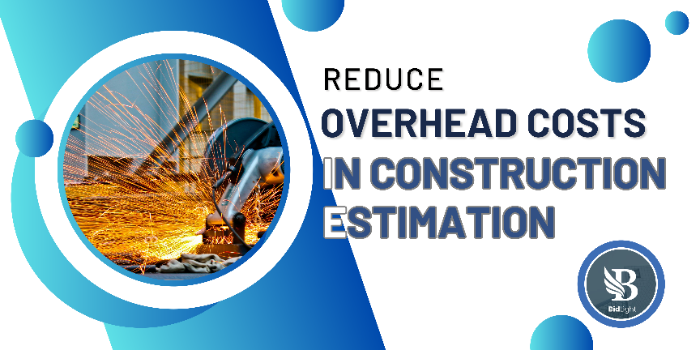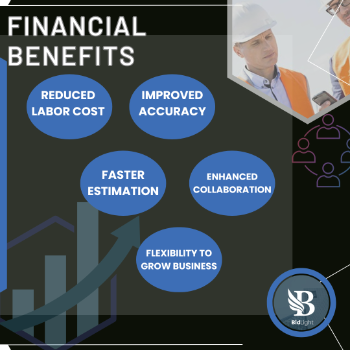
How Automation Reduces Overhead Costs in Construction Estimation
Accurate and efficient cost estimation is a cornerstone of successful project management in the construction industry. However, traditional estimation methods, relying on manual calculations and extensive paperwork, can be time-consuming and costly. As the construction sector continues to evolve, automation has emerged as a powerful tool to streamline estimation processes, reduce overhead costs, and enhance overall productivity. In this article, we delve into the financial benefits of automated construction estimation, supported by detailed case studies that illustrate how this technology is transforming the industry.
The Cost of Traditional Estimation Methods
Before exploring the advantages of automation, it's important to understand the financial burdens associated with traditional estimation methods. Construction estimation has historically been a labor-intensive process, often involving a team of estimators who manually calculate costs based on blueprints, material prices, labor rates, and other variables. While this approach has been the standard for decades, it comes with significant drawbacks:
Labor Costs: Traditional estimation requires a sizable team of skilled professionals who must dedicate extensive hours to preparing and reviewing estimates. This drives up payroll expenses, especially for large firms managing multiple projects simultaneously.
Time-Intensive Processes: The manual nature of traditional estimation means that it can take weeks or even months to produce a comprehensive estimate, particularly for complex projects. This delays project initiation and reduces the firm's ability to take on new work.
Increased Risk of Human Error: Manual calculations are inherently prone to errors, which can lead to inaccurate estimates. Even small mistakes in the estimation process can result in significant cost overruns, disputes with clients, and damaged reputations.
Inefficiency and Redundancy: Traditional estimation methods often involve repetitive tasks and redundant workflows, further increasing the time and effort required to produce accurate estimates.
.webp)
Given these challenges, it's no surprise that construction firms are increasingly turning to automation as a solution to reduce overhead costs and improve their bottom line.
The Rise of Automation in Construction Estimation
Automation in construction estimation involves the use of software and digital tools to streamline the process of calculating project costs. These tools leverage advanced algorithms, artificial intelligence (AI), and machine learning to analyze vast amounts of data and generate accurate estimates in a fraction of the time it would take using traditional methods. Key features of automated estimation tools include:
Data Integration: Automated tools can pull data from various sources, such as historical project data, material costs, labor rates, and market trends, to create precise estimates.
Real-Time Updates: As project parameters change, automated tools can instantly update estimates to reflect the latest information, ensuring that the estimation process remains accurate and responsive.

Error Reduction: By eliminating manual calculations, automation significantly reduces the risk of human error, resulting in more reliable estimates and fewer cost overruns.
Enhanced Collaboration: Many automated estimation tools include features that facilitate collaboration among team members, allowing for seamless communication and data sharing throughout the estimation process.
Financial Benefits of Automated Construction Estimation
The transition to automated construction estimation offers a range of financial benefits for construction firms. These benefits not only reduce overhead costs but also improve overall efficiency, enabling firms to take on more projects and increase profitability. Let's explore some of the key financial advantages in detail:

Reduced Labor Costs
One of the most significant financial benefits of automation is the reduction in labor costs. By automating repetitive and time-consuming tasks, firms can reduce the size of their estimation teams without sacrificing accuracy or efficiency. This translates to lower payroll expenses and allows firms to allocate resources to other critical areas of the business.
Improved Accuracy and Risk Mitigation
Automation greatly enhances the accuracy of cost estimates by leveraging data-driven algorithms and eliminating human error. Accurate estimates are crucial for avoiding cost overruns, which can erode profit margins and strain client relationships. By reducing the risk of inaccuracies, automation helps firms maintain financial stability and build trust with their clients.
Faster Estimation and Increased Revenue
Automation dramatically speeds up the estimation process, allowing firms to produce estimates in a fraction of the time it would take using traditional methods. This increased efficiency enables firms to respond to more bids and take on additional projects, ultimately driving revenue growth.
Enhanced Collaboration and Communication
Automated estimation tools often come with integrated collaboration features that allow different teams within a construction firm to work together more effectively. Improved communication and data sharing reduces the need for costly revisions and rework, further lowering overhead costs.
Scalability and Flexibility
Automation provides construction firms the scalability and flexibility needed to grow their businesses without a proportional increase in overhead costs. Automated tools can easily handle a higher volume of estimates, allowing firms to expand their operations and take on more projects without the need for additional staff.
Case Studies: Real-World Examples of Automation in Action
To further illustrate the financial benefits of automated construction estimation, let's examine some detailed case studies from construction firms that have successfully adopted this technology.
Case Study: Turner Construction – Labor Cost Reduction and Increased Efficiency

Company Overview: Turner Construction is one of the largest construction management companies in the United States, known for delivering high-profile projects such as sports stadiums, commercial buildings, and healthcare facilities.
Challenge: Turner Construction faced increasing labor costs due to the manual nature of its estimation process. The company also struggled with lengthy estimation timelines, which limited its ability to take on new projects.
Solution: Turner Construction implemented an automated estimation tool that streamlined the cost estimation process, reducing the need for a large team of estimators.
Results: The company was able to reduce its estimation team by 30%, resulting in significant labor cost savings. Additionally, the automation tool reduced the time required to prepare estimates by 40%, allowing Turner to take on more projects and increase its revenue.
Financial Impact: The implementation of automation led to annual savings of approximately $1.2 million in labor costs and a 15% increase in project capacity, contributing to higher overall profitability.
Case Study: Skanska – Improved Accuracy and Risk Mitigation

Company Overview: Skanska is a global construction and development company with operations in Europe, North America, and Latin America. The company is involved in a wide range of projects, from infrastructure and commercial buildings to residential developments.
Challenge: Skanska experienced frequent cost overruns due to inaccuracies in manual estimates. These overruns not only eroded profit margins but also damaged the company's reputation with clients.
Solution: Skanska adopted an automated estimation tool that utilized AI and machine learning to generate highly accurate cost estimates based on historical data and market trends.
Results: The automation tool improved the accuracy of Skanska's estimates, leading to a 25% reduction in cost overruns across its projects. The company also saw a significant improvement in client satisfaction due to the reliability and transparency of its estimates.
Financial Impact: Skanska saved millions of dollars in avoided cost overruns and secured additional contracts thanks to its improved reputation for delivering projects on budget.
Case Study: PCL Construction – Enhanced Collaboration and Reduced Rework

Company Overview: PCL Construction is a leading Canadian construction firm with operations across North America. The company specializes in commercial, institutional, and industrial projects.
Challenge: PCL Construction faced challenges with communication and collaboration among its teams, leading to frequent rework and project delays.
Solution: PCL Construction adopted an automated estimation platform that included integrated collaboration tools, enabling seamless communication between its estimation, design, and project management teams.
Results: The platform improved collaboration and reduced the need for costly revisions and rework. PCL Construction reported a 20% reduction in rework and a 10% improvement in project delivery times.
Financial Impact: The reduction in rework and improved efficiency resulted in substantial cost savings for PCL Construction, contributing to a stronger bottom line.
Case Study: Kiewit Corporation – Scalability and Cost Reduction

Company Overview: Kiewit Corporation is a Fortune 500 construction, engineering, and mining company with a diverse portfolio of projects across North America.
Challenge: Kiewit Corporation sought to expand its operations while keeping overhead costs under control. The company needed a scalable solution that would allow it to handle a higher volume of estimates without increasing its team size.
Solution: Kiewit Corporation implemented automated estimation software that provided the scalability and flexibility needed to manage a growing project portfolio.
Results: The software enabled Kiewit to scale its estimation capabilities without increasing the size of its team, resulting in a 15% reduction in overhead costs.
Financial Impact: The automation tool allowed Kiewit to successfully expand its operations while reducing costs, contributing to higher profitability and long-term growth.
Overcoming Barriers to Automation Adoption
Despite the clear financial benefits, some construction firms may be hesitant to adopt automated estimation tools due to perceived barriers such as cost, complexity, and resistance to change. However, these challenges can be overcome with the right approach:
Initial Investment: While there is an upfront cost associated with implementing automation technology, the long-term savings in labor, time, and overhead costs far outweigh the initial investment. Many software providers also offer flexible pricing models, making automation accessible to firms of all sizes.
Training and Support: To ensure a smooth transition to automation, construction firms should invest in training and support for their teams. Most automation software providers offer comprehensive training programs and customer support to help users get up to speed quickly.
Change Management: Resistance to change is a common challenge in any industry. To overcome this, firms should communicate the benefits of automation to their teams and involve them in the decision-making process. By demonstrating how automation can improve efficiency and reduce workload, firms can gain buy-in from their employees.
The Future of Automated Construction Estimation
As automation technology continues to evolve, the financial benefits for construction firms will only increase. Emerging trends such as artificial intelligence, machine learning, and big data analytics are poised to further enhance the accuracy, speed, and efficiency of automated estimation tools. Additionally, the integration of automation with other digital construction technologies, such as Building Information Modeling (BIM) and project management software, will create a seamless and interconnected workflow that maximizes productivity and minimizes costs.
AECOM
AECOM, a global infrastructure firm, is leading the way in adopting advanced automation technologies. The company has integrated automated estimation tools with its BIM platform, enabling real-time cost estimation based on 3D models. This integration has resulted in a 60% reduction in estimation time and a 30% improvement in accuracy, leading to significant cost savings and a competitive advantage in the market.
Embracing Automation for Long-Term Success
In today's competitive construction industry, firms that embrace automation in their estimation processes are better positioned for long-term success. By reducing overhead costs, improving accuracy, and increasing efficiency, automated construction estimation tools offer a clear financial advantage. The real-world examples and case studies presented in this article demonstrate the transformative impact of automation, highlighting its potential to drive profitability and growth for construction firms of all sizes.
As the industry continues to evolve, those who invest in automation technology will be well-equipped to navigate the challenges of the future, stay ahead of the competition, and achieve sustained success. Whether you're a small construction company or a large multinational firm, the time to embrace automation is now—it's an investment that promises significant returns in both the short and long term.
Check https://app.bidlight.com for how BidLight can help you estimate your BIM model!